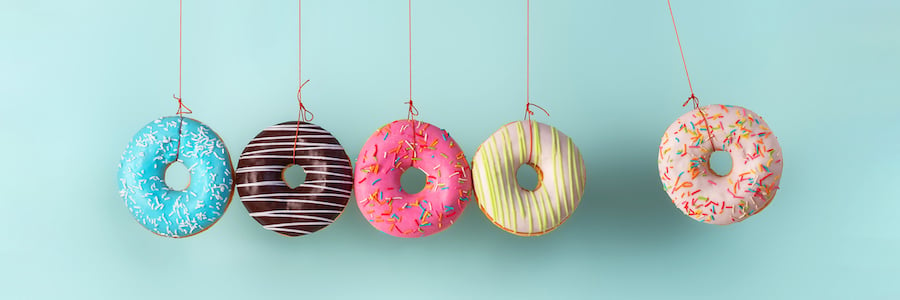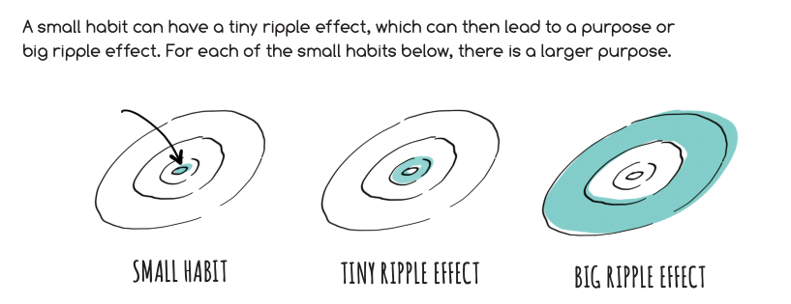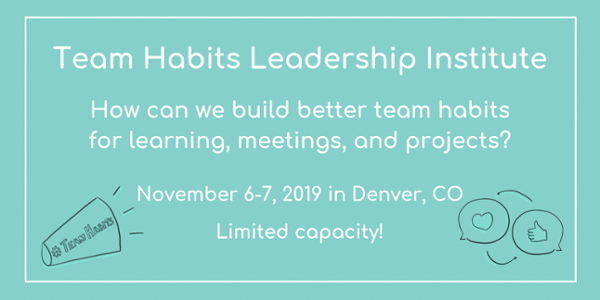
What Donuts Can Teach Schools and Teams About Lasting Change
School Districts | Innovative Leadership
“And we both hit our goal weight!”
“That’s amazing! So how did you celebrate?”
“We ate an entire box of donuts! And then gained all of it back.”
On an August visit with a group of teachers I’ve been partnering with for over a year, our conversation steered toward the idea of setting goals. In the education world, goals are set all the time, and often displayed or communicated prominently. A teacher may set the goal of 10 consecutive perfect attendance days, 90% of students showing mastery on an upcoming unit exam, or 100% of students growing 1-2 reading levels in a single year. Outside of the education world, too, we set goals all the time. Many of these are health-related – eat more greens, lose weight, drink more water, get more sleep. Some are financial goals – get a raise, save for a vacation, make a million dollars. And still others are achievement-based goals – write a book, buy a house, run a marathon. As the teachers I spoke with this summer shared, they set a goal to lose a set amount of collective pounds, and they did! But there was a huge problem with their apparent success. Two weeks later, they had gained it all back...and then some. They had hit their goal, but had failed to build a habit.
These teachers’ experience is a common one in any individual or organization solely focused on goals as a method to make changes. As James Clear writes in Atomic Habits, “Achieving a goal only changes your life for the moment.” It doesn’t create enduring success, but only momentary success. Yet, this is often the way teachers, schools, teams, and districts structure their vision for success. Is the goal we want to set aligned to the results we want to see? But as Clear continues, “We think we need to change the results, but the results are not the problem.” So what is the problem? Our habits or systems that we use. It’s just like placing a bucket under a leaky roof. We are focused on the results of having a clean and dry floor, but as soon as that bucket is gone, the problem persists. Instead, we need to fix the system or habit - in this case, the leak.
“Achieving a goal only changes your life for the moment. That’s the counterintuitive thing about improvement. We think we need to change our results, but the results are not the problem. What we really need to change are the systems that cause those results.”
- James Clear, Author of Atomic Habits
The word habit comes from the Latin word habitare, literally meaning to live or dwell. In the upcoming book, The NEW Team Habits, authors Anthony Kim, Keara Mascareñaz, and Kawai Lai define a habit as something that, “is a regular tendency, behavior, or practice. Habits are the things we do so often they become second nature.” Habits are part of a person’s daily life, and a team’s daily processes, and most of our habits aren’t even noticeable. Charles Duhigg, author of The Power of Habit, estimates that up to 45% of the decisions we make are habits. That’s nearly half of our waking hours! We don’t decide to brush our teeth. We do it by habit. We don’t decide to check email on our phone. We do it by habit. Habits are the powerful but silent drivers of our systems, and without intentionally building them, even if we end up hitting our goal, our success will be fleeting the second we eat the donut or remove the bucket.

So what does this mean for your school or district team? As we move to set new goals for an upcoming academic year, here are 3 tips to remember if we want to build habits that create lasting change on our teams, rather than momentary success:
Keep an eye out for The NEW Team Habits releasing this fall! Co-authored by Anthony Kim, Keara Mascareñaz, and Kawai Lai, The NEW Team Habits is the follow-up guide to the best-selling The NEW School Rules, created to help leadership teams transform the habits that keep them from success.
1. Implement 1 “tiny” change
Stanford Behavior Scientist, BJ Fogg, advocates for the introduction of a “tiny habit” as a way to create big change. Want to build a habit of flossing? Floss just one tooth. Want to build upper body strength? Fogg says to just do one push-up a day. Want to be able to disconnect from work at the end of the day? Delete the email app from your phone. Want more efficient meetings? Try 1 protocol designed to increase efficiency. The point is not that doing one push-up makes us strong, but that objects in motion tend to stay in motion (thanks, Newton and 8th-grade science!), and if we start with one tiny thing, it will have a gradual snowball effect that compounds over time and creates a bias toward action.
2. Start with what feels “safe enough to try”
Frequently, team decisions and actions get bottle-necked as leaders look to build consensus or the perfect plan before actually trying something out. Anthony Kim and Alexis Gonzales-Black write in The NEW School Rules, “When staff and school teams [adopt a mindset of] ‘safe enough to try’ instead of consensus, it can become a mantra that empowers teams to take action.” Often what prevents us from beginning is feeling like we are not ready or worrying about an error or failure. But failure is the oldest way to learn and in fact, IS learning. By operating with a safe enough to try mindset that a proposal is good enough to test without harming our schools, students, or teams, and that we desperately need failure data to learn what works and has an impact, we can compel the change we want to see by focusing all of our efforts on just putting out a minimum viable product and iterating as new data comes in.
“When staff and school teams work with the New Rules of aim for ‘safe enough to try’ - a phrase that is used in the practice of Holacracy - instead of consensus, it can become a mantra that empowers teams to take action.”
- Anthony Kim and Alexis Gonzales-Black, Authors of The New School Rules
3. Think like a scientist, and test!
Our understanding of habit cycles has given us a lot of insight into how you can both build good habits and disrupt bad ones. Made famous more recently by Duhigg as the “Cue-Routine-Reward” loop, research has shown that every habit - good or bad - has three phases. Variations of this three-part habit loop exist, but the essence is the same. Duhigg says the “cue” acts as a trigger for a behavior to start, just like waking up and having a craving for coffee. The “routine” kicks in, which is the habit itself, like going into the kitchen and starting the coffeemaker. Then the final phase is the reward, or what trains your brain to make your behavior automatic by desiring to repeat the cue-routine pattern. The reward, in this case, is that hot cup of caffeine. If the reward is perceived as desirable, this cycle eventually causes your brain to crave the coffee, making the cycle habitual.
If you wanted to set a goal to, say, drink less coffee by building a different habit, you have to figure out how to give yourself the same reward by testing a different routine until you get the same jolt of energy as the coffee provides. As you experiment with different routines and find the one that delivers the same reward as that cup of coffee, over time, you will develop a new craving that can overwrite the old habit.
The same can be said for leaders wanting to build new team habits. Let’s take a weekly meeting for example. Some leaders have told us that attendees walk in and immediately begin venting. It’s become a habit to start the meeting off on this foot. To test ways to build a different type of habit, the leader could test different starting routines. The cue is the entry into the meeting space; the routine is the act of venting, and the reward is the feeling that person gets of being seen and heard. Why not try out another routine like a meeting check-in that helps people also feel seen and heard, but in a positive way that disrupts the habit of venting? Or test playing music as attendees walk in?
As districts and schools gear up for a new school year, they ramp up the writing of new strategic plans, team projects, and school-level goals. But if we want to see lasting change as evidenced by hitting our goal, we have to begin by building better team habits. Otherwise, we will gain all of our “old weight” back until we are just left with donut crumbs.
Want to learn more about building team habits? Register to attend our New Team Habits Institute in Denver on November 6-7. In the meantime, pre-order The New Team Habits: A Guide to the New School Rules to kickstart lasting change on your team or leave a note below to connect.

Author’s Note: P.S. This blog post is not an indictment on donuts. They are delicious and provide a much-needed service in the comfort food industry, but if you build better habits, you can enjoy the donut guilt-free. In D.C.? Check out my favorite donut shop.
About Gabrielle Hewitt
Gabby Hewitt is a Partner at Education Elements, working directly with large and small schools and districts to impact student growth and success. She spent six years in the classroom as an 8th grade U.S. History Teacher, first in Prince George’s County, Maryland, and later with KIPP DC. In her first year in the classroom, she was selected to receive the Maryland Association of Teacher Educators Distinguished Teacher Candidate award. During that time, Gabby also wrote the county-wide history curriculum for middle schools and assisted the Prince George’s County Social Studies Department with the rollout and integration of the Common Core State Standards. Gabby led teams as both the Social Studies Department Chair and Eighth Grade Level Chairperson before leaving the classroom to train and manage the development of resident teachers in her charter network. As the Manager of Professional Development for the Capital Teaching Residency program with KIPP DC, she developed skills in planning and facilitating adult professional development, project management, and effective teaching evaluation models. Gabby holds a B.S. in Political Science and a B.A. in Mass Communication from Louisiana State University. She earned her M.S. in Educational Studies from Johns Hopkins University. Born and raised in New Orleans, Gabby currently lives in the Washington D.C. area with her husband and three little ones. When she is not working, you can find Gabby pursuing her passion for photography or enjoying a good cup of coffee.


